3DMark 2003
Year of release: 2003
Developer: Futuremark Corporation
Platform: PC
Minimum system requirements:
Operating system: Windows® 98/SE/ME/2000/XP
Processor: x86 compatible processor, 1000MHz
RAM: 256MB of RAM (512MB recommended)
DIRECT X: DirectX ®9.0 compatible graphics adapter that has 32MB of memory and is fully DirectX®7.0 compliant
Like 3DMark 2001, the previous creation of the Finnish guys, the new 3DMark03 is a complete set of gaming and synthetic tests, as well as, of course, a stunningly beautiful demo created on Based on gaming tests:
 |
 |
GameTest 1: Wings of Fury :
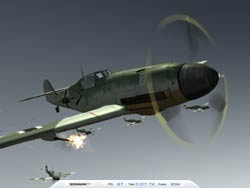 |
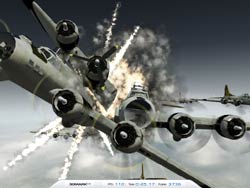 |
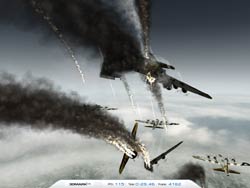 |
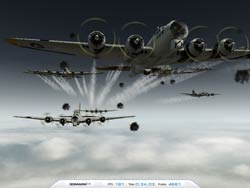 |
situation has developed with simulators: while the graphics in other 3D games becomes more and more complex, games of this class, as a rule, lag far behind in terms of using the power of 3D accelerators from the same ones, for example, shooters.
Such an interesting situation played into the hands of Futuremark developers: while processing databases with user reports, they discovered (and this is not surprising) a huge number of "old" systems with video cards that only support DirectX 7 functions at best. When developing 3DMark03, they took this moment into account
, and created a test that does not require hardware support for DirectX 8 and DirectX 9 functions from video cards. The idea of a flight simulator fit here perfectly.
The test uses classic multitexturing, the maximum number of simultaneously applied textures is four. Moreover, multitexturing is required only when rendering aircraft: this is the base color texture, the specular map, the lightness map, and the specular intensity map, which determines which details reflect light more intensely and which ones less. All other objects - earth, clouds, smoke, etc. - have only one texture layer.
The most significant load on accelerators in this test is imposed by numerous effects of flames, smoke trails, clouds, etc. Point Sprites (if there is hardware support) and traditional “quad particles” (a pair of triangles with a common edge) are used to draw them.
To process geometry, in the case when the video card has hardware support, vertex shaders version 1.1 are used.
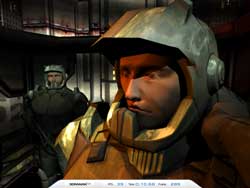 |
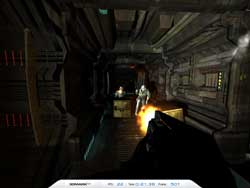 |
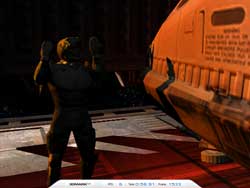 |
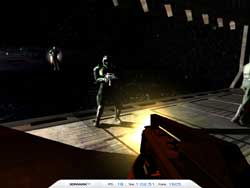 |
The Battle of Proxycon test scene demonstrates another class of 3D games - first-person shooters.
The action takes place on a spaceship: enemy paratroopers land on the landing deck and move deep into the ship. A firefight ensues between them and the defenders...
First-person shooters (FPS), in keeping with the tradition established by Quake and Unreal, are at the forefront of 3D technology. In order to give the player a sense of reality, it is no longer enough, as in simulators, to meticulously recreate the physical model of the behavior of an aircraft from the Second World War or to achieve a perfect match of the virtual image to the real prototype. In FPS, first of all, it is important how the world looks like, because it is with it that the player will interact.
Not surprisingly, the Battle of Proxycon test puts forward higher demands on the graphics card: it requires hardware support for DirectX 8 features.
The most impressive detail of the test is dynamic shadows. The stencil buffer is used to build dynamic shadows. All geometry processing is performed using vertex shaders version 1.1, but in the case when the accelerator does not have the appropriate support, this work will be assigned to the central processor. Nevertheless, support for pixel shaders version 1.1 is required: they are used to apply textures, apply normal maps to simulate bumpiness, calculate shadows, diffuse and specular reflections of light sources.
Accelerators with hardware support for pixel shaders version 1.4 get a significant advantage in this test: if with pixel shaders version 1.1, to display most objects, one pass of the accelerator is required to initialize the Z-buffer and three passes for each light source (calculation of the stencil buffer, alpha buffer and specular/diffuse light reflections), then with shaders version 1.4 and above, only one pass per light is required.
In this test, you can enable Post Processing, that is, the processing of the constructed image to obtain additional cinematic special effects. The first effect, “Depth of Field”, is the “blurring” of objects that are not in the focus of the camera. The second, no less beautiful effect, "Bloom", simulates a blurred halo around the bright areas of the image.
In addition to demonstrating the triumph of modern graphics technology, Game Test 2 also repeats other actions performed by real game engines: the collision of characters with each other and with the environment is calculated in real time in accordance with the laws of physics.
The total information on the Battle of Proxycon test scene looks like this: on average, there are about 250,000 polygons in the frame (when using pixel shaders version 1.4 - about 150,000 due to fewer passes of the accelerator), textures take 80 MB of video memory, vertex buffers - 6 MB, for index buffers - another 1 MB of video memory.
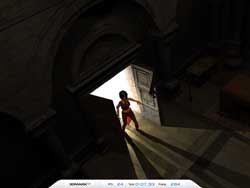 |
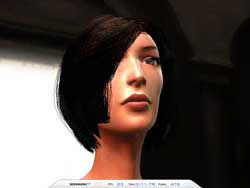 |
 |
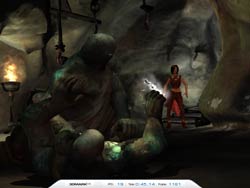 |
The action takes place in an old castle. A pretty girl, armed with a magic sword, explores the interior of the room and suddenly discovers a secret door that opens a corridor to the dungeon. Two trolls did not expect the appearance of the hapless adventurer...
This test also uses the capabilities of DirectX 8-compatible accelerators. It differs from the previous test in a smaller number of textures, but in a large number of polygons. For example, polygon models were used for the hair of the main character, and anisotropic lighting was used to make the curls look realistic.
This test also uses vertex shaders version 1.1, pixel shaders version 1.1 or 1.4, dynamic shadows, normal maps, etc. are present in the scene. Just like in Battle of Proxycon, Post Processing effects can be enabled here. To calculate the collision of characters in real time, as in GameTest 2, the licensed “engine” Havok is used here.
The total information on the Troll's Lair scene looks like this: on average, there are about 560,000 polygons in the frame (when using pixel shaders version 1.4 - about 250,000 due to fewer accelerator passes), 64 MB of video memory is used for textures, 19 MB for vertex buffers, for index buffers - 2 MB of video memory.
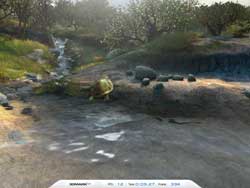 |
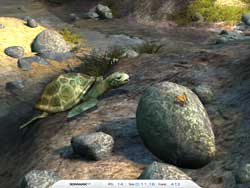 |
 |
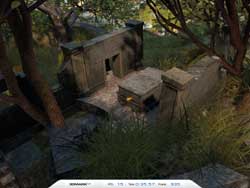 |
Just as 3DMark2001's Nature test showed the new features of DirectX 8, 3DMark03's Mother Nature demonstrates what can be achieved using the capabilities of a new generation of DirectX9-compatible accelerators. There is no plot in this scene - just a beautiful summer day in nature. Sun, sky, stream, grass, sand, funny turtle :)…
The tree foliage and grass in this test is done differently from the Nature test from 3DMark2001. If earlier these were textures depicting entire branches of trees and “bunches” of grass, now each blade of grass and each leaf is a separate object. The animation of the leaves - swaying in the wind - is set through the vertex shader version 2.0. The animation of the blades of grass is set using the vertex shader version 1.1.
The water surface is rendered using Pixel Shader 2.0. The shader uses wave, normal, specular, refraction, transparency, and cube specular maps to simulate water reflections from distant objects. To display the sky, another feature provided by DirectX9 is used - increased fidelity of data representation.
When rendering the surface of the earth, pixel shaders version 1.4 are used, using information from base textures, light maps, textures that simulate the microstructure of the surface, and normal maps.
The summary information for the Mother Nature scene looks like this: on average, there are about 780,000 polygons in a frame, 50 MB of video memory is used for textures, 54 MB for vertex buffers, 9 MB of video memory for index buffers.
 |
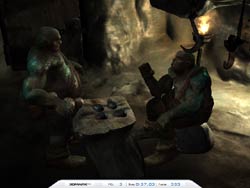 |
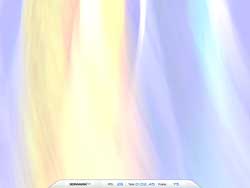
This test since 3DMark 2001 has changed only externally, the essence has remained the same. In the Single-Texturing mode, the accelerator displays 64 planes with one texture on each at the highest possible speed. In the Multi-Texturing mode, fewer planes are drawn, but the accelerator renders each plane with the maximum possible number of textures. The total number of texture layers should be 64, so if the accelerator, say, supports overlaying a maximum of 6 textures in one pass, then it will draw 10 planes with six textures on each, and overlay the remaining four texture layers on the 11th plane.
Vertex Shader:
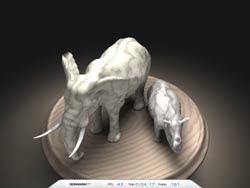 |
 |
The Vertex Shader benchmark measures the execution speed of vertex shaders. With the help of vertex shaders, characters are skinned, of which there are already 30 pieces in the scene. Each model has about 5500 polygons and is rendered using Pixel Shader version 1.1 in 4 passes. As a result, this results in an impressive figure - 660,000 triangles in the frame.
Pixel Shader 2.0:
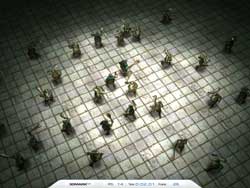 |
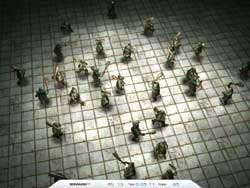 |
This test shows how fast animal models are rendered using 3D procedural textures defined with Complex Pixel Shader 2.0.
Ragtroll:
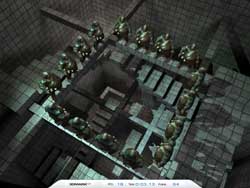 |
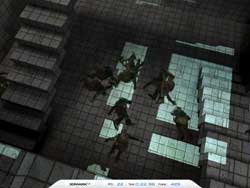 |
16 crazy trolls alternately throw themselves from a great height ...
The Ragtroll test shows how efficiently it is possible to distribute calculations between the graphics chip and the central processor. Character skinning is done by the GPU using Vertex Shaders 1.1, while collision physics is calculated in real time by the CPU.
Sound Test :
Sound subsystem tests allow you to check the correct operation of 3D sound algorithms, such as positioning in three-dimensional space, Doppler effects, etc., and evaluate the speed drop when a large number of 3D sound sources are turned on.



